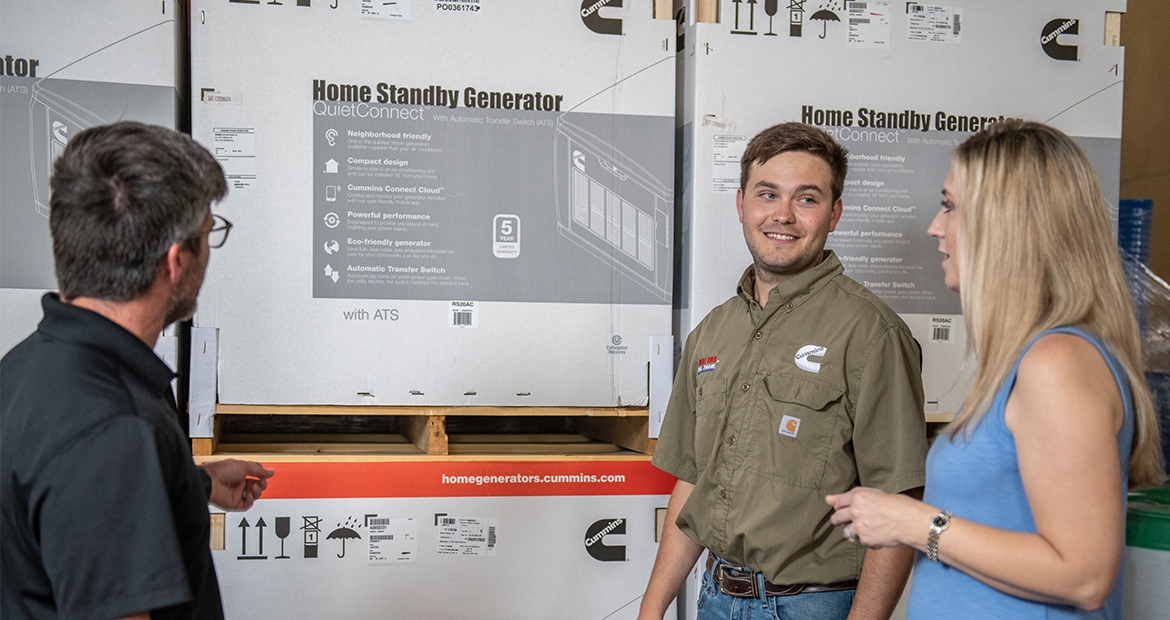How to prepare before the next big ice storm freezes you in

The weather is getting worse and your family may be at risk. Here are some tips to help you and your family prepare for the next big ice storm.
If you’re anything like the rest of us, at some point this year you were scrolling through your favorite feed and passed an article about the latest severe weather event. The headline probably exclaimed something about the “worst storm on record” or “strongest storm in history”, and it was likely followed by some images of sheer destruction. We’ve all seen them.
And again, if you are anything like the rest of us, you probably thought to yourself “wow, the weather has been crazy lately!”
Trust us, you are not alone.
But did you ever pause over that image of devastation and think to yourself “how would I guide my family through something like this?” or “what would we do if this was happening here?”
You should be.
That feeling of “this is crazy” is not wrong. Far from it. In fact, severe weather events are getting more intense and more frequent. You’ve seen it for yourself.
Despite the somewhat magical image of the sun shining off fresh icicles in the crisp morning air, ice storms can actually be the most dangerous and damage-causing storms on the planet. In just a few hours an entire region can be paralyzed by icy roads, no power, and so many downed trees that it can take weeks to clear.
The scary part is, these fast-hitting storms can sweep in with little warning, taking trees and power lines with them. And once the power fails, your once-warm and inviting home can transform into an icebox where your loved ones huddle under blankets, struggling to stay warm. Thousands of dollars worth of food will spoil in your freezer, and one after another, freezing pipes will burst, cascading freezing water through the walls of your home.
Only, it doesn’t have to be that way.
Proper preparation, like the information you’ll find below, can see you and your family through ice storms in comfort and safety.
That is, as long as you listen to that little internal voice that said “what will we do if this happens here?” and accept that the weather you’ve already seen, isn’t the weather you’ll see in the future.
Severe Weather Is Getting Worse, And More Frequent
Most of us can remember several severe weather events that happened in the last few years. It seemed like every few months we were hearing about the latest “Storm of the Century” or “storm of a lifetime”.
Here are a few severe weather events from just the last nine years:
- Halloween 2011, a Nor’easter you might remember as “Snowtober," incapacitated the entire northeast region. The storm set snow accumulation records in at least 20 cities. 3.2 million people in 12 states went without power, some lasting over 10 days.
- January 28-29, 2014, a very rare severe weather event crippled the deep south, dropping inches of ice in Alabama, Georgia, and Florida. The storm was so severe that 233 consecutive miles of Interstate-10 was closed in both directions.
- March 2017, a severe Nor’easter blanketed the entire Northeast with snow, breaking several records. Snowfall accumulations topped 30” in many spots, with a staggering 48.4” recorded in Ostego County, NY.
A recent article in The New York Times explored the multiple scientific research studies being published that show a strong upward trend in the frequency of severe weather events.
So our eyes are not deceiving us: severe winter weather events are definitely on the rise. And when they do hit, there is a good chance they will be more severe and damaging than any winter storms we’ve already lived through.
Why Ice Storms Should Concern You More Than a Blizzard
Reality: an ice storm is not “just another winter storm.”
First: ice is heavy. A half-inch of ice can add 500lbs to power lines or trees and a full inch means 1,000lbs hanging from everything. Even big trees can’t deal with that amount of weight, and it doesn’t take long before they all start falling. Often taking the power lines with them.
There is also no getting around the fact that the United States is living with a power grid mostly installed in the 1950’s and patched together with “fixes”. A recent Department of Energy report plainly stated that the increasing severity of weather events is guaranteed to continually increase power outages in affected areas.
Meaning, during an ice storm, power outages are inevitable.
Second: We aren’t talking about a few trees falling here. We’re talking about dozens of trees per street, all blocking roads, driveways, and houses. And it can take an hour or more to remove larger trees. If there are live power lines tangled in the tree, that tree has to remain untouched until the power company can cut the power.
Buried under their own mountain of emergency calls, the power company may not get to that tree for days. So, if your house is blocked by that tree, you aren’t going anywhere.
That scenario can repeat thousands of times across a region after an ice storm blows through.
The final factor is the most obvious one: after an ice storm, everything is covered in ice!
Ice makes it difficult to even go outside, let alone clear roads and downed trees. Iced-over streets are nearly impossible to drive on, and icy driveways and walkways lead to falls that break bones or dislocate joints.
The reality is, if you can’t go somewhere safely, neither can the power company. Or tree workers, firefighters, police officers - even gas station attendants. Everyone is affected by ice.
It’s not hard to see how these three factors can quickly turn a fun “snowstorm” into a nightmare scenario.
So what can we do?
We prepare.
Preparing for Ice Storms
When it comes to dealing with ice storms, the most important thing to prepare against is the bitter cold.
Without electricity or another heat source, the temperature inside the average house can fall to uncomfortable levels within hours. Left unchecked, a house can get into the 30's in just a few days.
Don’t fool yourself. It doesn’t have to be arctic-frigid in your house for one of your loved ones to start getting hypothermic. The CDC tells us that hypothermia can set in above 40°. Hypothermia is nothing more than your body losing heat faster than it can produce it. So if your loved ones feel cold, then they can also get hypothermia.
Don’t leave that to chance by saying “well that will never happen to us”.
Prepare For The Cold With These Easy Tips:
- Keep a stockpile of warm blankets in central locations. Pick blankets of thick wool, feather down or fleece because they offer the better best insulation.
- Find a central spot in your home you can close off. Smaller rooms, with the windows, doors and hallways blocked off with blankets, can be much easier to heat. Pick this ahead of time and put blankets there.
- Make sure you have enough fuel for alternate heat sources and be very clear in how to operate them! Using a fuel-burning heat source indoors can very easily produce deadly carbon monoxide gas, which is colorless and odorless. A buildup can spell death for everyone in the house. Read all warning labels and instruction manuals, closely.
- Keep enough water and food on hand for at least a week. Without power, your pipes may freeze, so fresh water may become a limited resource. Store extra. Easy-to-heat meals and simple carbohydrates are also easy to store and can become go-to snacks that will keep your family fed. Malnourished people are more likely to develop hypothermia, and shivering requires energy. Don’t be afraid to store more than you think you’ll need.
- Create plans for your more vulnerable loved ones. Small children and older adults are at greater risk for cold-related injuries and death. Put together plans ahead of time to get to your at-risk loved ones before the storm and get them to a place where they will be safe.
The Ultimate Step in Ice Storm Preparation
If you noticed earlier, most of the risks from ice storms come from having no electricity in your house. Power outages rob your home of all the resources you would normally use on a cold day to stay warm, stay connected, and remain productive.
Reality: Once the power goes out, you are on your own to solve your own problems.
So, instead of relying on the aging power grid that suffers more power outages than any other developed nation, on earth, you can take matters into your own hands. Armed with a good standby generator, you can guarantee your family’s safety on your terms by keeping the power on no matter what happens.
Widely considered the gold standard in storm preparation, whole home generators are the single most important investment a family can make against winter disasters. Fueled by a nearly limitless supply of natural gas, these generators automatically turn on, and take over during a power outage.
Out of town on business? Trapped at the office? Welcome to a worry-free storm. Your generator is right there, ready to take over without anyone having to lift a finger.
Working from home? Kids remote-learning? Keeping the power on means staying connected. Cell sites and communications centers all have backup power sources, so many connection options are still available.
And picking the right generator can make all the difference. We’re talking about your safety net to prevent disaster. This is the time to go for the best you can find.
For instance, Cummins Home Generators are backed by over 100 years of industry experience building engines and generators designed for extreme conditions. If you’ve seen a firetruck, semi-truck, or even a diesel Ram pickup truck, then you’ve seen a Cummins engine at work. They also make the generator of choice for data centers, major hospitals, and US military bases overseas. If Cummins keeps the lights on at a major hospital, your family will be in the best hands.
Before you can even say “hey the power is out” your generator will be running and providing power. Your lights will come back on and your heat stays running. No matter what.
Just imagine, your house is surrounded by a completely dark neighborhood during a severe ice storm. What is your family doing? They’re grabbing a cold drink from the fridge, microwaving some popcorn, and watching a movie. Warm, safe, and provided for.
Guarantee Your Sanctuary
There is no denying that winter storms are getting more frequent, and more severe.
The “storm of the century” seems to happen once a winter now, and each one is stronger than the last. With no end in sight, we should worry about making sure our loved ones have what they need to survive the next severe ice storm. We should take those extra steps to prepare for the worst. Because it is coming.
As storms get stronger, losing power is no longer just a possibility. It is an eventual certainty.
How you respond when that storm arrives and cuts off your power, is a matter of how you prepare today.
Take the tips we provided seriously. Get your plans in place.
And consider finding your nearest Cummins Dealer for a painless estimate on that gold standard of storm preparation: a reliable whole home generator from a well-known company that also offers financing through Synchrony Bank. You’ll never know if it’s worth it until you need it.
Don’t wait until that happens.


